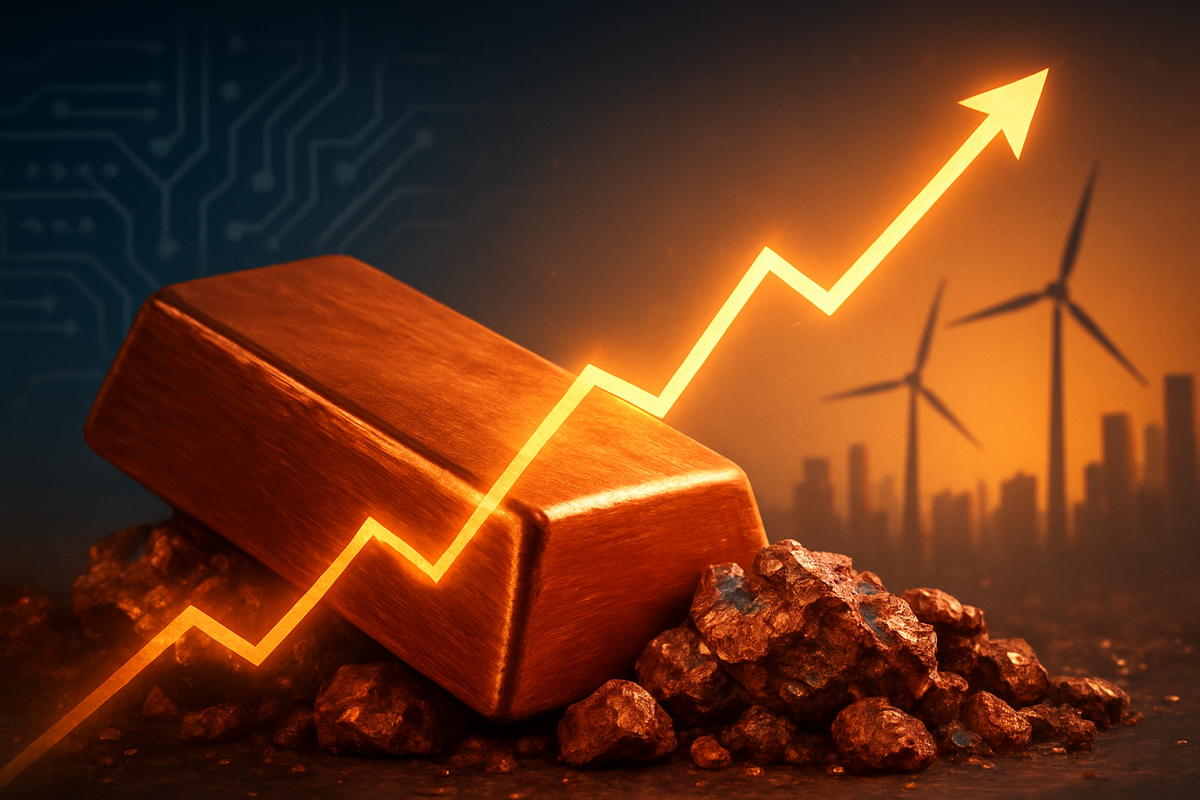
The resolution of a historic U.S. government shutdown, which spanned an unprecedented 43 days from October 1 to November 12, 2025, has sent a powerful jolt through the global commodity markets, with copper leading a dramatic surge that is reverberating across the broader industrial metals sector. This immediate "recovery rally" has seen the red metal not only reclaim lost ground but also push to record highs, signaling a profound shift in market sentiment and underscoring copper's critical role in the evolving global economy.
The shutdown, triggered by a congressional impasse over appropriations legislation, had initially cast a shadow of uncertainty over industrial demand. However, the eventual signing of a funding bill by President Donald Trump on November 13, 2025, unleashed a wave of "risk-on sentiment," encouraging investors to pour back into commodities. This swift rebound, particularly in copper, suggests that underlying demand drivers are robust enough to quickly overcome political disruptions, setting the stage for what many analysts are terming a "new copper supercycle."
The Spark: Government Reopening Ignites a Bull Run
The immediate aftermath of the U.S. government reopening saw copper prices surge to unprecedented levels. The benchmark three-month copper on the London Metal Exchange (LME) gained approximately 0.9% to trade between $10,815 and $10,822 per metric ton as hopes for an end to the shutdown grew on November 10, 2025. This contributed to a remarkable 23% year-to-date advance for LME copper, which had already hit a record peak of $11,200 on October 29, 2025. The Shanghai Futures Exchange's most traded copper contract also saw a significant rise, closing up 0.6% at 86,480 yuan ($12,140.95) a ton. US benchmark copper prices surged by as much as 44.5% from the end of 2024, reaching an intraday high of $5.959 a pound on July 24, 2025.
Several factors converged to fuel this dramatic rally. Optimism over the government reopening generated a "risk-on sentiment," while the anticipation of U.S. interest rate cuts, spurred by recent weak economic data, further boosted investor confidence in commodities. Crucially, strong economic signals from China, including easing producer price deflation and a return to positive consumer prices in October, provided a bedrock of demand. Analysts noted resilient end-user demand and increased purchasing orders as prices adjusted. Adding to the buoyancy was speculation around potential U.S. tariffs on refined copper, with traders paying high premiums for shipments to the United States. The Trump administration was reportedly reconsidering plans to impose tariffs on refined copper in the coming year, which added to price buoyancy.
The positive ripple effect extended across the broader industrial metals market. Aluminum on the LME advanced by 1.1% to 1.6%, reaching between $2,879.50 and $2,893.50 per ton. Zinc gained between 1.4% and 1.5% to $3,099-$3,101, while lead prices rose by 0.7% to 0.8%, reaching $2,061.50-$2,062.50 a ton, supported by a 21% slide in LME inventories. Nickel added between 0.3% and 0.8% to $15,105-$15,180, and tin was up by approximately 0.9% to 1% at $36,195-$36,125. This widespread rally reignited enthusiasm in commodity markets. However, the upward momentum for copper began to stutter by November 13, 2025, as weak lending data from China tempered the positive sentiment, suggesting that sustained strong demand, especially from China, would be crucial for the rally to continue.
Corporate Fortunes: Winners and Losers in the Copper Boom
A sustained surge in copper prices, as witnessed throughout 2025, creates clear winners and losers across various public companies. Mining and production companies are the primary beneficiaries, while manufacturing sectors heavily reliant on copper face significant headwinds.
Companies Poised to Win
Copper mining and production companies directly benefit from higher commodity values, experiencing enhanced revenues, expanded profit margins, and stronger cash flows. This financial boost enables them to accelerate exploration and development projects, reduce debt, and improve shareholder returns.
- Freeport-McMoRan Inc. (NYSE: FCX): As one of the world's largest publicly traded copper producers, FCX is significantly leveraged to copper prices. Its major assets, including the Grasberg mine in Indonesia and extensive operations in Arizona, ensure that a sustained price surge directly increases its sales revenue and profit margins.
- BHP Group (NYSE: BHP): This global natural resource producer holds significant copper mining operations in South America (including a majority stake in Escondida, the world's largest copper mine) and Australia. BHP is actively investing in expanding its copper production, allocating nearly half of its total capital expenditure to the metal.
- Southern Copper Corporation (NYSE: SCCO): As one of the largest integrated copper producers globally, SCCO boasts low production costs and extensive reserves in Mexico and Peru. A surge in copper prices significantly widens its profit margins.
- Rio Tinto Group (NYSE: RIO): This diversified global mining company, with key copper assets like a co-ownership in the Resolution Copper project in Arizona and the Oyu Tolgoi mine, stands to benefit substantially. Rio Tinto reported a 10% increase in Q3 2025 copper output compared to the previous year.
- Teck Resources Limited (NYSE: TECK): This Canadian mining company has been increasing its copper production, notably from the ramp-up of its Quebrada Blanca mine in Chile. Higher copper prices enhance its revenue and profitability from these growing operations.
- KGHM Polska Miedź S.A. (WSE: KGH): This Polish state-run company is a major global copper and silver producer whose earnings are highly correlated with global commodity prices. KGHM reported an 80% increase in its Q3 2025 profit due to strong performance and higher metal prices.
- Lundin Mining Corporation (TSX: LUN): Lundin Mining has increased its full-year copper production guidance for 2025 and lowered its cost guidance, benefiting from improved grades and decreased treatment and refining charges.
- Taseko Mines Limited (TSX: TKO; NYSE American: TGB): Taseko reported improved third-quarter 2025 financial results, with increased copper production and lower operating costs at its Gibraltar mine. The company expects strong copper prices in 2026.
Companies Facing Headwinds
Companies in manufacturing and related sectors that rely heavily on copper as a raw material will face significant headwinds. The surge in copper prices directly increases their input costs, threatening profit margins, potentially delaying projects, and driving up consumer prices, which can lead to "demand destruction."
- Automotive Manufacturers (especially Electric Vehicle Producers): Electric vehicles (EVs) consume significantly more copper—up to four times that of traditional cars. A sustained surge directly escalates production costs for major automakers like General Motors (NYSE: GM), Ford Motor Company (NYSE: F), and Tesla, Inc. (NASDAQ: TSLA).
- Electronics Industry Companies: The electronics industry depends heavily on copper for printed circuit boards (PCBs), wiring, and various power devices. A copper price surge translates directly into increased manufacturing costs, affecting profitability across this diverse sector.
- Cable and Wire Manufacturers: Companies in this sector use copper as a primary raw material. Fluctuations and surges in copper prices directly define their margins. While they may attempt to pass on increased costs, there is typically a lag, and they may explore alternatives like aluminum where feasible.
- Construction and Infrastructure Companies: The construction sector is a major consumer of copper. Higher copper prices directly increase project costs, potentially delaying or reducing the scope of new construction and infrastructure projects.
Broader Implications: A New Copper Supercycle
The copper price surge, amplified by the U.S. government shutdown resolution and the subsequent industrial metals rally, is widely considered to signal the advent of a "new copper supercycle." This reflects a profound transformation in the global economic and industrial landscape, where copper is becoming an even more critical strategic metal.
The rally is deeply embedded in several transformative industrial trends. The most significant is the Green Energy Transition, where copper is indispensable for electric vehicles (EVs), renewable energy infrastructure (solar panels and wind turbines), and smart grid modernization. EVs demand significantly more copper, and the expansion of charging infrastructure also heavily relies on it. Renewable energy generation systems, like wind and solar, require substantial copper inputs for generators, wiring, and transmission. Additionally, Artificial Intelligence (AI) Infrastructure is emerging as a significant new consumer of copper for power distribution and cooling systems in data centers. Finally, global infrastructure spending initiatives further boost demand. These trends contribute to projections of robust copper demand growth, with some estimates suggesting a 50% increase by 2040.
The ripple effects are extensive. While copper producers are clear winners, copper-consuming industries face challenges. Manufacturing, construction, electronics, and automotive sectors will experience significantly higher raw material costs. This could lead to "demand destruction" or an increased search for alternative materials like aluminum, though often with performance trade-offs. Globally, higher copper costs contribute to inflationary pressures and complicate central bank efforts to manage inflation.
Regulatory and policy implications are also significant. The U.S. Geological Survey's November 2025 designation of copper as a "critical mineral" elevates its strategic importance, potentially improving funding access for North American developments. Furthermore, the U.S. has implemented and threatened tariffs on copper imports, aiming to secure domestic supply and boost U.S. production, a trend towards "resource nationalism" that could further fragment global markets. Historically, copper prices have exhibited cyclical patterns, but the current supercycle is distinguished by the unprecedented confluence of demand drivers—energy transition and AI infrastructure—combined with persistent structural supply issues, suggesting a more sustained period of high demand and prices.
What Comes Next: Navigating a Volatile Yet Bullish Future
The future outlook for copper and industrial metals is poised for significant shifts, marked by both short-term volatility and a strong long-term bullish trend. The resolution of the U.S. government shutdown provided an immediate demand recovery, with renewed federal infrastructure spending and normalization of procurement processes. However, market volatility is expected to persist, influenced by ongoing inflation, potential interest rate adjustments by central banks, and geopolitical tensions. China's economic performance and policy stimuli will remain critical short-term determinants.
Long-term, the outlook is overwhelmingly positive, driven by fundamental structural changes. The electrification and energy transition is the most significant driver, with copper indispensable for EVs, renewable energy, and grid modernization. Demand for copper alone is projected to rise dramatically, with estimates suggesting a 70% increase by 2050. This surge, combined with supply deficits—exacerbated by declining ore grades, limited new discoveries, and long lead times for new mines—points to a widening gap between demand and supply as early as 2031. Digitalization and Artificial Intelligence (AI) infrastructure also represent substantial new demand drivers.
Companies in the metals sector will need to make strategic pivots, focusing on cost control, operational efficiency, and technological investment in advanced extraction and processing. Supply chain resilience and diversification are crucial to mitigate geopolitical risks. Prioritizing sustainability and ESG factors will be vital for maintaining a social license to operate and attracting investment. Strategic capital allocation should focus on copper-rich areas, and the integration of metal recycling into operational models can help alleviate primary supply pressures.
New market opportunities abound in green technologies, AI infrastructure, and sustainable sourcing. However, significant challenges loom, including acute supply deficits, price volatility, geopolitical risks, environmental pressures, and capital intensity of mining projects. Potential scenarios for the coming years include a "New Copper Age" with sustained high prices and structural deficits, or a scenario where innovation and recycling partially alleviate pressure. Conversely, critical shortages and decarbonization delays could occur if new supply fails to materialize adequately.
Wrap-Up: Copper's Enduring Significance
The recent copper price surge, spurred by the end of the U.S. government shutdown, has underscored copper's increasing sensitivity to both political stability and fundamental supply-demand dynamics. The event has reinforced copper's status as a critical metal for modern economies, particularly with the accelerating demands from electrification, AI, and data centers.
The episode highlighted the fragility of global supply chains and the strategic importance of copper, factors that may contribute to a stronger case for higher prices in the long run. While government shutdowns can cause short-term disruptions and volatility, their lasting impact on the underlying bullish trend for copper, driven by structural demand growth and supply constraints, is likely to be minimal. The market is moving towards a future defined by persistent supply deficits and robust demand.
For investors in the coming months, a discerning eye is crucial. Monitor global economic data, especially from China, as well as Federal Reserve policy and the U.S. dollar's strength. Keep a close watch for any supply disruptions and assess geopolitical developments and trade policies, particularly regarding copper tariffs. Despite short-term fluctuations, the long-term structural bull case for copper remains intact due to demand from the energy transition, AI, and infrastructure. Investors with a longer horizon might consider this underlying strength, while also reviewing global copper inventory levels as critically low stocks can amplify price movements during periods of increased demand or supply shortfalls.
This content is intended for informational purposes only and is not financial advice






